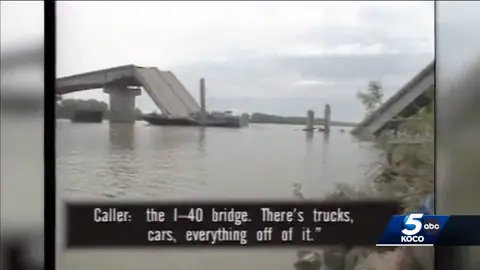Webbers Falls bridge tragedy in 2002 sparks catalyst for change across Oklahoma
On May 26, 2002, the Interstate 40 bridge over the Arkansas River at Webbers Falls collapsed into the water after being hit by a barge, killing 14 people and injuring 11 others.
On May 26, 2002, the Interstate 40 bridge over the Arkansas River at Webbers Falls collapsed into the water after being hit by a barge, killing 14 people and injuring 11 others.

On May 26, 2002, the Interstate 40 bridge over the Arkansas River at Webbers Falls collapsed into the water after being hit by a barge, killing 14 people and injuring 11 others.
On May 26, 2002, the Interstate 40 bridge over the Arkansas River at Webbers Falls collapsed into the water after being hit by a barge, killing 14 people and injuring 11 others.
"It was an awful day," said Tim Gatz, the current Oklahoma Department of Transportation director who was in his 12th year at ODOT at the time. "It definitely is a day to remember. Still to this day, you know, it pulls emotions out of you."
Gatz says that tragedy served as a catalyst that has since launched Oklahoma's state bridges from next to last in the nation to a top 10 ranking. Getting there and maintaining it, however, is a huge effort.
"It's taken two decades for us to do that, but we've made progress for those entire two decades," Gatz said.
Video Below: From the KOCO 5 Archives: Recovery efforts after 2002 Webbers Falls I-40 bridge collapse
By law, bridges must be inspected at least once every two years. Each one of them is graded on a scale of one to 10 in three categories: the bridge deck (what we drive on), the superstructure (or beams) and the foundation. If any one of those categories are rated a four out of 10 or lower, the entire bridge is considered structurally deficient or poor.
ODOT maintains nearly 6,800 bridges across the state. In 2004, almost 1,200 of them were structurally deficient, which accounted for 17% of the state's bridges. That was 49th in the country.
In 2023, the number of poor bridges was down from 1,200 to 45.
Gatz told KOCO 5 that being structurally deficient does not mean they are at risk of collapse.
>> View the informational graphic below to see US bridge condition ratings since 1992
"If we ever saw bridge infrastructure that we believe was problematic in that manner, we've closed it immediately until we could get a fix to that," Gatz said.
The economics of fixing and maintaining bridges are challenging.
"So, sometimes it's going to be a fact that we may come in and we need to go and repair a bridge or do some maintenance on a bridge instead of replacing it, because we have to consider what those impacts would be, especially economically," said Jason Giebler, the state bridge engineer for Oklahoma.
Gatz said the state must continue to invest, because the cost of construction has skyrocketed.
"If you look at the first quarter of 2021 through the first quarter of 2024, the construction cost index for heavy highways has gone up about 60%. So, our buying power has been reduced," he said.
Another challenge facing Oklahoma is that the move to the top 10 does not include all bridges.
The national bridge inventory tracks not just the 6,800 bridges maintained by the state but also about 8,500 other bridges maintained by Oklahoma counties and cities. In the most recent data obtained by KOCO 5, more than 1,400 bridges, or 9% of bridges, in Oklahoma were considered structurally deficient.
So, when all of Oklahoma's bridges are counted, the state ranks not in the top 10, but rather 36th.
By the numbers, Gatz, Giebler and ODOT are doing their part. The state engineer said he's proud of how far they've come.
"I was in college in 2022 when the Webbers Falls bridge fell down, and seeing where we've come from, from there, because it's not just the aspects of the inspection cycles that were going out there, but how everybody came together to work on the designs. And then the Legislature and our contracting companies that are out there and working together to come together and as a whole entity within Oklahoma to address this," Giebler said.




